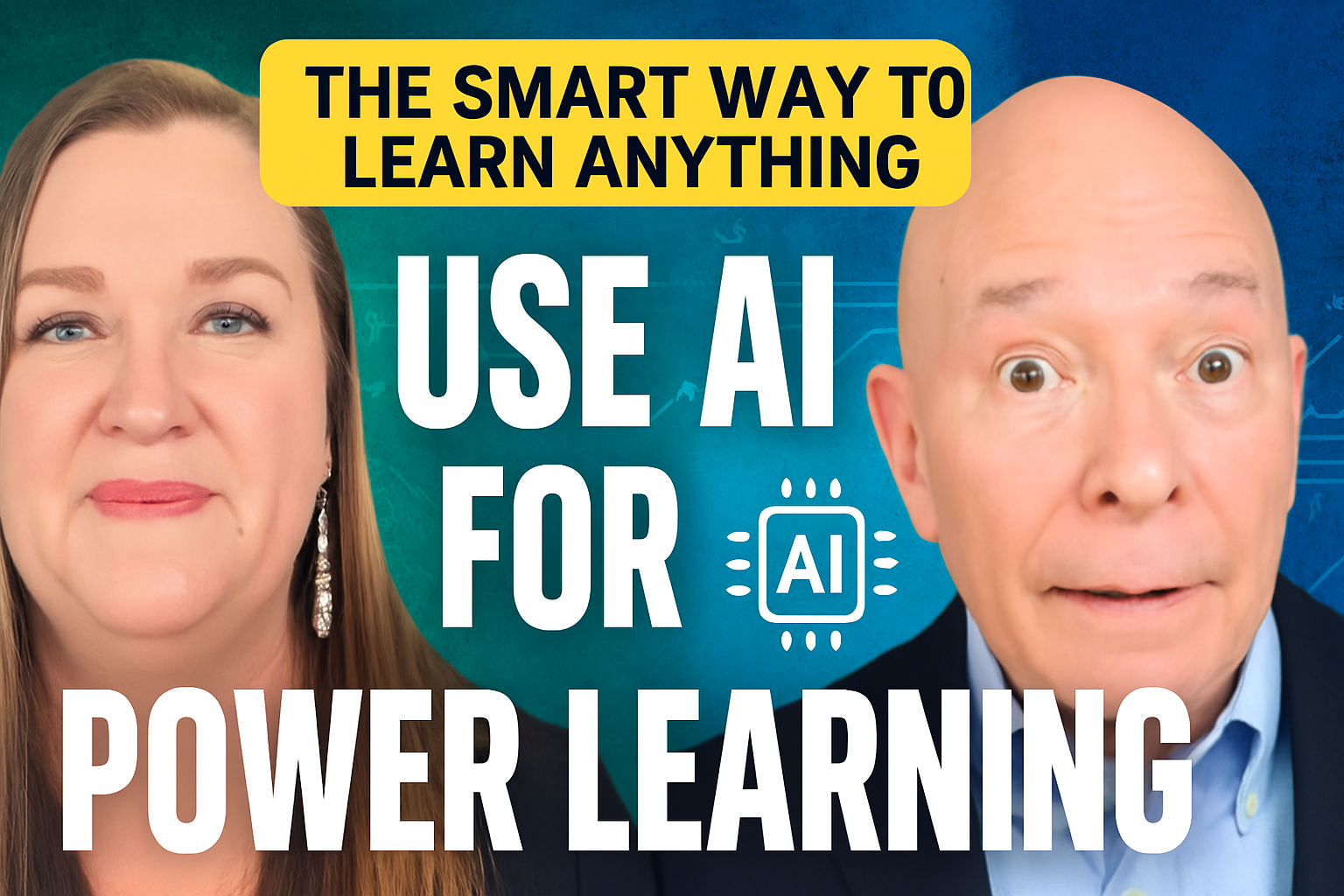Discover how AI is revolutionizing education and transforming learning experiences for students and educators alike!
In this video, I share an interview I had with Toni Gist, Clinical Assistant Professor in Food Science and Human Nutrition at UIUC, University of Illinois, Urbana-Champagne.
We explore the cutting-edge power of Arist AI, an innovative tool reshaping classrooms with personalized learning, 24/7 accessibility, and scientific rigor.
This is a powerful tool that helps students learn faster and better. It is also great to instructors, like Toni, who can customize their instructions to fit the style of individual students.
In this video you’ll learn how educators are using AI to supercharge student engagement, cater to diverse learning styles, and streamline teaching strategies, all while embracing the human connection.
From interactive chatbots to AI-driven insights, see how institutions like the University of Illinois are paving the way for smarter, more dynamic education.
Curious about how AI tools can empower both students and teachers? Join us to uncover actionable strategies to transform your approach to learning and teaching.
#education #edtech #adaptivelearning #aitools #airevolution
Recommended AI tools for business growth.
http://AItools4biz.com
Here’s a link to the video:
Listen to this & other episodes on our podcast
https://bit.ly/sre_podcast
For Your Convenience, Here’s Some Timestamps of This Episode
CHAPTERS:
00:00 – Intro
01:18 – Why Toni Chose Arist AI: Decision Factors
04:04 – Implementation of Arist: Strategies and Techniques
05:32 – Student Experiences: Feedback and Outcomes
07:54 – 24/7 Access and Repetition: Benefits of Continuous Learning
09:49 – AI Tutor and Engagement Data: Enhancing Learning Interactions
11:49 – Measuring AI Success in Education: Metrics and Evaluation
14:04 – Future of AI in Education: Trends and Innovations
18:04 – Addressing Educators’ Concerns: AI and Job Security
21:23 – AI’s Impact on Writing Process: Transformation and Tools
21:38 – Outro
For your convenience, here’s a Spanish language transcript:
En este episodio, Terry Brock dialoga con Toni Gist, una profesora asistente clínica en la Universidad de Illinois en Urbana-Champaign, sobre el impacto de la inteligencia artificial (IA) en la educación, utilizando una herramienta específica llamada ARIST AI. Terry destaca la importancia del aprendizaje a lo largo de toda la vida y cómo las herramientas de IA están revolucionando el proceso educativo.
Toni Gist explica que ARIST AI es un asistente virtual que juega un papel crucial en su clase al actuar como un chat bot entrenado. Esta herramienta permite la entrada de voz, enlaza a materiales de primer nivel, resume información y ofrece a los profesores la capacidad de ajustar el nivel de detalle de las respuestas. También puede crear podcasts cortos que resumen las preguntas más comunes de los estudiantes y proporcionan recomendaciones pedagógicas.
La decisión de implementar ARIST AI en su clase estuvo influenciada por la receptividad y capacidad de respuesta personal de Toni Gist, uno de los creadores del software. Toni Gist resalta la importancia de esta interacción cercana, lo que ha permitido personalizar ARIST AI para satisfacer las necesidades específicas de su clase.
En cuanto a los resultados de la integración de ARIST AI en el sistema de gestión de aprendizaje, Toni menciona que los estudiantes han utilizado la herramienta de manera efectiva. Los estudiantes hacen preguntas a ARIST AI, que ofrece respuestas precisas y bien fundamentadas, basadas en fuentes científicas confiables, a diferencia de otras IA no entrenadas. Esto ha mejorado significativamente la alfabetización científica de los estudiantes.
La herramienta también ha facilitado un acceso 24/7 al aprendizaje, permitiendo a los estudiantes estudiar a su propio ritmo y en sus horarios preferidos, sin tener que depender exclusivamente de explicaciones repetitivas en clase. Esto se traduce en un aprendizaje más adaptado a las necesidades individuales de cada estudiante.
Además, Toni Gist menciona el uso del tutor de IA incorporado que le ayuda a identificar las preguntas frecuentes antes de sus clases, lo que le permite preparar sesiones más dinámicas y centradas en las inquietudes reales de los estudiantes. Esto ha resultado en evaluaciones más altas de la enseñanza, ya que los estudiantes sienten que sus necesidades son mejor atendidas.
También reflexiona sobre el futuro de la inteligencia artificial en el ámbito educativo y más allá, especialmente en el campo de la salud y la nutrición. Destaca la posibilidad de que herramientas como ARIST AI revolucionen la forma en que los profesionales de la salud personalizan y comunican la información a sus pacientes, basándose en datos científicos.
Por último, Toni Gist aborda las preocupaciones que pueden tener algunos educadores sobre la IA, mencionando que, si bien hay temores sobre el desplazamiento de empleos, la implementación correcta de la IA puede, de hecho, aumentar las oportunidades de empleo y mejorar la eficiencia en la educación. Concluye enfatizando que la combinación de la inteligencia artificial entrenada con la atención humana puede dar lugar a una comunicación más efectiva en el proceso educativo.
For your convenience, here’s an English language transcript:
Terry Brock [00:00:00]:
I love learning, and I’m sure that you do too as an entrepreneur, someone who’s learning regularly. Lifelong learning is something we embrace. And now with AI, there are some tools that are frankly mind boggling being used right now in many different levels. Recently, I had an opportunity to talk with a clinical assistant professor at UIUC. You may think what in the world is that? Well, that’s University Illinois Urbana Champaign. Her name is Toni Gist. Toni Gist is a wonderful lady who enjoys learning, teaches her students how to do that, and is now tapping into a great little tool, a wrist AI, like Aristotle. That’s where they get the name.
Terry Brock [00:00:43]:
Aristotle, She tapped into this and is showing us now how we can use it, how they’re using it at a university level. It’s helping the students to learn better, learn faster, learn twenty four seven whenever it’s coming for them. And you know what students are like, going anytime crazy hours all the time. And this is available to them. It’s helping them and also can help you and me. So I’m gonna give you a sneak peek into this. Now, by the way, the folks that do a wrist AI that are manufacturing and doing are a client of mine. I get a chance to work with them and see it.
Terry Brock [00:01:12]:
I wanted to share this in a special interview for you so you can see behind the scenes what’s going on, get an idea of what’s going on. So get ready for this wonderful lady, Toni Gist, who is gonna be able to help you understand how this works and what can be done with new AI technology. Get ready for a wonderful learning experience.
Toni Gist [00:01:36]:
There’s a lot of excitement right now in the field of education and learning because of AI. There’s tools out there that really give you the ability to really learn in a way that taps into the way the natural brain works. Yeah. I know it sounds kind of funny, but using technology to make sure that we can understand better is what it’s all about. And there’s a tool that’s being used now widely more and more by educational institutions around the country and around the world now using this because it gives the ability for technology to help students learn faster and learn better depending on their learning style because we know there’s different kinds of styles. It works very well with you so that you’re able to adjust it. Many universities are looking at it and studying and trying to decide, okay, which one should we go with? There’s few out there and we see one emerging quite often now over and over that people like to look at it. It is ARIST AI, kind of like Aristotle and that’s really where it gets the idea of Aristotle with AI, ARIST AI and one of the people that’s using that right now is joining us right now.
Terry Brock [00:02:39]:
She’s over in the University of Illinois Urbana Champaign and she is able to talk to us about a lot of different, areas and how they’re using it right now. Her name is Toni Geist. Toni, thanks for being with us today.
Toni Gist [00:02:53]:
My pleasure. Thank you for inviting me, Terry.
Terry Brock [00:02:55]:
Toni, you have done a lot with this. I know you studied a lot of different tools out there. So you were looking at many areas out there. You decided to go with ARIST AI to be able to see what it’s like and there what What were some of the factors that you looked at and what you’re seeing in it right now?
Toni Gist [00:03:10]:
One of the things that I love about Arist AI is that it is a chatbot in my class that is trained. So So that’s one of the components of the suite of ARIST AI, but that’s the one I’m using most extensively right now. And it can, have voice input. It links you to first source materials from your class. It summarizes things, and you, as the faculty member have the ability to decide at what level you want the answer. Do you just want it to point the students towards that first source material from your course? Or do you want it to explain it in a unique way? And it can even create something that’s kind of fun. It can even create podcasts now. So I know for myself, my time is very valuable.
Toni Gist [00:03:57]:
At the end of the week, it can create this three minute podcast that tells me the most common questions. It tells that my students are asking. It even gives instructional suggestions as to how to present the material in a different way or make sure that I’m being as clear as possible with those students. It’s, it’s fantastic from an educational standpoint, from start to finish.
Terry Brock [00:04:19]:
Yeah. I can see how that would be real nice. Well, let me roll you back in time when you were looking at it. You’re first looking at there and we see that, Tony Guest is looking at thinking, okay, I’m thinking about this one, maybe some other choices. What was the thought process that you went through that made you decide, okay, I think we’re gonna go with this one?
Toni Gist [00:04:36]:
To be honest, it was that personal touch. I met Toni Gist, who is one of the brilliant minds behind it, And he’s someone who is always looking to evolve, always looking to learn from the faculty members. And so anything that I’ve asked him to do, like, oh, can we, show calculations in this way? And can I get outputs automatically sent to me? He’s like, Yes. Can I have it where there’s a help button where students can click on it and then it’ll automatically email me with a question that they have? He’s like, Sure. So he’s someone who is very responsive and I have never found that from any educational platform to date other than with Aris AI and with Toni Gist. So to me to have that individual who’s listening to you and then has the knowledge, skill, and ability to implement something new, based on your feedback is golden. And he does it quickly too, which is exciting.
Terry Brock [00:05:36]:
Yeah. That sounds important. They’re very interested as I’ve talked to them about how it’s implemented, what happens, and how to do that. Tell me about how you went about using this and implementing it as it integrated with a learning management system. I know a lot of institutional educational leaders are looking at what are we gonna do? We’re using an LMS right now, and they wanna integrate it. What process did you go through there at University of Illinois?
Toni Gist [00:05:59]:
Well, I myself, Teach about a thousand to 1,500 students per semester. So I have a large teaching team. So what I did was I asked my teaching team how they thought it would be best implemented. And then we talked with Toni Gist and he worked with us and what we landed on was that it would be embedded. So we, we create an embed code and we have it within a discussion board in the class itself. And the discussion board says, help. I have a question. And so the students can click on that and not only does it have ARIST AI, but then the students, if their question isn’t answered, they then can post on the discussion board.
Toni Gist [00:06:41]:
And I will have to say that I have not one student who has posted on the discussion board. They’ve all been engaging with ARIST AI specifically because we did want a, a two factor way for students to make sure their question was being answered. And it sounds like ARIST AI is answering their questions very effectively, right there embedded in that discussion board in the learning management system seamlessly.
Terry Brock [00:07:07]:
That sounds fantastic the way it’s doing. Well, tell us a little bit more about the specific examples. Have you thought of some students and what their experiences has been and what have they said to you and to others? What kind of feedback are you hearing about their educational experience with it?
Toni Gist [00:07:22]:
Well, I teach a class, in nutrition. Nutrition has so many myths and misconceptions. And one of the activities I have my students go through is to log into another, you know, AI software and ask a question that might be a common myth or misconception and find out what the response is. Well, many other external non trained software AI options will just pull from like blogs and other places, that may not be as reputable. And then I asked them to ask a question from ARIST AI and see what the difference is with respect to the scientific. Rigor and the students are like, oh my goodness. I didn’t realize how much misinformation is being Perpetuated with a non train chat bot. That’s drawing from information from all over the internet versus one where you’re saying, look, here are the reputable sources.
Toni Gist [00:08:20]:
Here are the things you need to look at here is what I want you to learn so that you can set up a solid foundation in this topic. And so the students are saying that their scientific literacy is going up because one of the things that I love about ARIST AI is that it actually provides links to that first source material in my class. So then they can go and explore further. And the other thing that they like is they said that it, it draws them in almost like, you know, how they get into this, like doom scrolling on their phone. Sometimes the videos will on ARIST AI, it’s almost like a deep dive into the information because they’ll ask one question. ARIST AI will answer it. And then ARIST AI says, are you curious about these other things? And then the students can click on those other things and be like, yes, I am curious about it. And I’ve seen students where they just kind of keep linking deeper and deeper into the topic and really engaging with the material that we have in a different way, rather than just a lecture video.
Toni Gist [00:09:16]:
It’s, it’s, it’s more of a conversation with their interests and pointing them to where in the class they can find that information.
Terry Brock [00:09:24]:
That sounds like it’s embracing much more natural way of learning the way that we as human beings learn. They’re doing it more. Matter of fact, I wanted to ask you a little bit more about that with the idea and the benefits of twenty four seven access and also for repetition. Hey, we know that repetition is really good at learning, but after a while, even the best of human beings get a little annoyed with the same questions over and over, but a wrist AI kinda works around that. I’d love to hear it from your perspective how you’ve seen that work in the real world with students.
Toni Gist [00:09:53]:
So with students who are engaging with Airst AI, what I’m seeing is I’m able to spend less time in the classroom doing just what you said, repeating myself, saying it three different ways. Because when I say it once some students get it, they don’t want to hear it a second time or a third time from me. What they want is they want to hear it from me in a concise, clear manner. And then if they are at home or it’s late at night, or it’s a situation where, they just want to engage with the material in a different way, they want that option too. So it allows for multiple modalities of learning to occur rather than just like, remember when I said this, let’s go over it one more time. And it allows them to not be as sick of me. When I’m providing them a video and an announcement, all these things where they feel peppered by me, It allows them to be the leader and step forward into the material in a way that they want and ask the questions they want without feeling like they might, not get a response for an hour or a day. So they can engage at 2AM and do their homework and have their own tutor pretty much, drawing only on course materials.
Toni Gist [00:11:09]:
So they know that the material will be accurate and representative of what’s expected of them to learn.
Terry Brock [00:11:15]:
Sounds like amazing benefits that are there because we’re blending in the best of human ideas of how we learn with the technology from Arista AI and what it is doing there, the kind of capabilities that it has. Well, I know also there’s an AI tutor that’s built in there to look at engagement and how students have done from the educators point of view. What are some of the advantages you see of that?
Toni Gist [00:11:37]:
Well, I, teach my in person class as well as having all these online components in addition. And so as I’m preparing for walking in that classroom and making that time with my hundreds of students as effective as possible, I go into ARIS AI and I can look at what questions have been asked to ARIS AI the past few days. And then I can assimilate those questions in a meaningful way, walk into the classroom prepared. And in fact, this past Wednesday, I walked in with, instead of doing a traditional lecture or another gamify situation, I said, we’re going to do an AMA ask me anything. And let’s start with some of the most common questions that you all asked ARIST AI and I, and I put them up on the board and then we just kind of popcorn and went back and forth. And it was this very dynamic conversation. And I always ask for feedback from my students in their attendance quiz that they turn in and the feedback I got was, wow, Now I feel like I know enough to ask even more questions. And now they say, now I feel like I can empower myself and figure out how much protein I need given my physical activity.
Toni Gist [00:12:49]:
Thank you for taking those basic questions that were asked through ARIST AI. And then we have this dynamic engaging conversation based on the student’s interests because otherwise, no offense to myself, I’m a 50 year old woman who wears readers and I think I’m hip and cool and the students really like me, but at the same time, I may have missed the mark on what I think they’re interested in. So it gives me a tap into what they want to spend time with.
Terry Brock [00:13:18]:
That’s most important. I applaud you for that because you’re listening to them, not just saying, well, I think I know what’s right as too many people do. You are saying, let me look at what they’re doing. And matter of fact, one of the things that hits me right now, I’m thinking about any metrics that you’re seeing that can measure students are doing better by 23.7% because of this or something like that. Are there any metrics that come to mind that you’ve seen regarding their use of working with the tool?
Toni Gist [00:13:42]:
I give them some autonomy, so I don’t really track the students with their questions, to be honest. That is something that I believe Arista has the capability of doing. However, I want them to feel free and open to ask whatever questions they might have, to Arista AI in that space. So what I have seen though is my, what they call ISIS scores or end of semester evaluation scores. Have been the highest they have ever been and they’ve been good. Like I’ve been recognized for my teaching in the past. So it’s not that I was an instructor who anyone was concerned about. However, I got almost perfect marks in several spaces and to have hundreds of students summatively giving their feedback and you getting marks of 4.9 out of five, four point nine, five out of five.
Toni Gist [00:14:37]:
I feel that the communication has become more effective through the introduction of artificial intelligence, because I know that some faculty are like, oh, I don’t want to do artificial intelligence. I don’t want to implement it. In fact, I want it away from my classroom, because it takes away from that human connection. Well, I I’m finding the complete opposite. I’m literally finding that allows me to more effectively communicate with my students and meet them where they’re at.
Terry Brock [00:15:06]:
Yeah. I think that’s most important. You know, we’re seeing the same thing. As odd as it seems, AI is helping us to humanize that connection more. You think, how can a machine do that? Well, it is, and it seems like, of course, we know that’s the most important. If it’s just a robot, we’re gonna reject it. But if it’s a robot that’s been trained to help us and to address those areas where we can open up, it might take me five, ten, 15 times or more to learn a given concept, whatever it might be just because in that area, that’s not my learning style. But the AI can be there to help us.
Terry Brock [00:15:36]:
It seems like that’s gonna be something that’s gonna be more with us in the future all the time as we work with it. What are your thoughts on that?
Toni Gist [00:15:43]:
I definitely think that that’s going to be the case. It has allowed me to, empower my teaching team. Also, we have drop in office hours from 9AM to 3PM through Zoom, with my teaching team where students can pop in and ask a question because we do have so many students in our class. Some of my teaching team, they need a little bit of mentoring and hand holding, because they’re, they’re still learning the topics themselves. Well, now I have empowered my team with ARIST AI. So when a student stops in the virtual tutoring center and they ask a question about, well, I’m working out three times a week and I am unsure how much protein I actually need. They can talk to the TA or that teaching assistant and the teaching assistant can be there with ARIS AI. And so collectively they can dive into that first source material by sharing the screen, showcasing what’s going on and continuing the conversation.
Toni Gist [00:16:39]:
So in reality, I’m noticing that it’s changing the dynamics with not just my students with the material, but my teaching team, as well as how we communicate holistically. So I feel like it’s streamlining those times when students do stop in those office hours, as well as allowing them more depth with those responses and giving them direct links to that first source information. Like in the lecture video at three minutes and twenty three seconds, you can learn more. Here’s where it’s at.
Terry Brock [00:17:08]:
I love it. Sounds like what you’re doing is really you’re not going either or. You’re going both and. We take the best in technology and we can remember that human caring being there with both. We wouldn’t want one without the other. We’re able to do both, and it seems like that’s where we’re going. So what I wanted you to do is we rant wind things up here. You reach out to your desk there and get that crystal ball of yours.
Terry Brock [00:17:27]:
I hope the battery will start you and rub it together real well there, and I’m gonna ask you about real long term, like, six months from now. Long term at AI would be six months or so, but tell us, what do you see happening in future developments? What kind of things do you anticipate happening? What would you really like to see happen? Boy, if I could wave a magic wand here and make this, this, and this happen, that would be it. What would some of those developments and some of those future enhancements be?
Toni Gist [00:17:54]:
I love that question. So for myself, I would love to see this technology hit the clinical sector in the field of health and nutrition. That’s where I would love to see it because there’s so much, again, misinformation out there with other AI generated responses. But if we could say, let’s say we have a group of clinical registered dieticians, and they have a really unique situation with a client and the client is presenting with this different, you know, blood work and concerns and health outcomes. And we train ARIST AI with reputable up to date scientifically based first source materials that have been peer reviewed. And then we can input the general information from that client into it. I feel that we can then give that client more tailored, directives than we otherwise would because we are human and we might be overlooking one little piece of a puzzle, but with the combination of a trained chat bot, like ARIST AI or ARIST AI suite and that human connection where we’re listening and responding, I feel that healthcare could actually benefit quite a bit.
Terry Brock [00:19:17]:
Absolutely. I think a lot of health care will come from the benefits of AI as we use it right. Like with any technology, there’s pros and cons. I often talk about, hey, airplanes are great technology. We know it is the safest form of transportation. But are there problems? Well, sure. Have people died? Yes. But we learn from that.
Terry Brock [00:19:35]:
We don’t give up because there’s a negative. We pursue it and understand where we’re going from there. So in that light of that, what would you say to that educator, that professor, someone who’s in academia that’s looking this? They want the very best for their students and they’re concerned about AI taking jobs away or hurting those students in some way or the other. What would you say to that person who’s watching this concerned about it and wondering where we’re going about AI and how that works with other technologies?
Toni Gist [00:20:03]:
I love that question Terry because there is a lot of fear associated with, embracing and implementing AI technologies And what I would say right now is the train is leaving the station. You’re either going to get on it or you’re going to be left behind that we can’t put this back in a box and pretend like it doesn’t exist. What we need to do is empower our students to use it effectively, show them the pros and the cons of using something that is trained, versus something that is untrained with regard to artificial intelligence. Let them understand that it is going to open up accessibility to a lot of other people that may otherwise not have opportunities in different jobs because they don’t have either accessible media. They’re having a hard time interfacing with the technology. I feel that artificial intelligence, especially if done properly is going to open up job opportunities and actually streamline those processes. I know myself. I’m going to be honest.
Toni Gist [00:21:04]:
I have students who email me a question and I lean into my train chat bot and I say, Hey, ARIST AI, this is what the student has a question on. Can you, author an answer for them? That has, that focuses on care and concern for their health and well-being. And it will author a short little blurb. I obviously read it. I revise it, but I know that that message is clear then. And I have now also reinforced what resources I may have forgotten that I put out there and train the, the ARIS AI with. And so I feel that, It is actually making communication more effective. I feel like it’s opening up, job opportunities for those that might not otherwise be there.
Toni Gist [00:21:47]:
And I also feel that it’s going to allow us to be much more efficient in our workspace.
Terry Brock [00:21:54]:
I love it. I would have to agree with you strongly. They were doing it the right way, carefully learning as we go, realizing, okay, this is new waters. We’re in a territory we haven’t been in before. We’re learning from that and growing. Toni, thank you so much for being with us. We really appreciate you joining us here from there at the University of Illinois.
Toni Gist [00:22:12]:
Thank you, Terry. Again, I appreciate you inviting me.
Terry Brock [00:22:15]:
And for those of you listening to this, think about the ways that you can use this, the power that is available when, as Toni says, you take the best of the Aristotle that we have, the wisdom of Aristotle blended into a wrist AI, and we take the best of human caring, how we can really help. Put those two together, not either or, put them together. And I love the way she said it as well. That it’s not just a matter of taking something here and pasting it in. Too many times we’ve heard just copy and paste. No. No. No.
Terry Brock [00:22:40]:
I like to say you wanna copy paste and then customize. Write it yourself. Let let what AI gives you be the first draft, the rough draft. And then you go in there and you ize it. Make it you. Put in your voice. Put in their feelings and experiences that you’ve had. This is the way to do it.
Terry Brock [00:22:59]:
And when we look at a wrist AI, it has the tools for this. It’s blown me away as a jaded journalist. You know, we’d sit back and go, yeah. Right. Uh-huh. Sure. But I look at this, I’m going, this is really good stuff. It’s good for learning, and it’s good for growing.
Terry Brock [00:23:14]:
Take a look at it. I’m Terry Brock. Thank you very much for joining us today.















